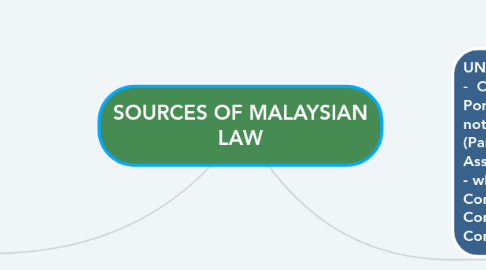
1. WRITTEN LAW ▪ The law that have been codified or recognized by the Federal and State Constitution. ▪ It is also embodied in a code or statute including subsidiary or delegated legislation.
1.1. FEDERAL CONSTITUTION
1.1.1. DEFINITIONS
1.1.1.1. • Supreme law of the land • Islam as the religion of the federation. • The most important source of law-applicable to all states
1.1.1.2. • Establishes the Federation as a constitutional monarchy having the YDPA as the Head of State. • Any general law that is inconsistent with the constitution is void.[refer A.4(1)of FC]
1.1.2. MAIN BRANCES
1.1.2.1. The establishment of three main branches 1) Parliament: House of Representatives (Dewan Rakyat) & the Senate (Dewan Negara) 2) The executive (led by the Prime Minister & his Cabinet Ministers 3) The judicial branch headed by the Federal Court
1.2. STATE CONSTITUTION
1.2.1. DEFINITIONS
1.2.1.1. • Regulates the government of that particular state - Each state has its constitution. • The powers of a state is provided in the ‘State List’ of the FC. • State may make laws, includes Islamic Laws, Malay customs, land, mining, forest, agriculture and local government. • However, the central government may intervene for the purpose of ensuring uniformity of law and policy.
1.3. LEGISLATION
1.3.1. DEFINITIONS
1.3.1.1. • Legislation refers to law made by either Parliament (Federal Level) or State Legislative Assemblies (State Level).
1.3.2. TYPES
1.3.2.1. • ACT - Refer to law enacted by Parliament after 1957 • ENACTMENT - Refer to law enacted by State Legislative Assemblies. • ORDINANCE - Refer law enacted by Parliament after 1946 but before Malaysia's independence in 1957 - Refer to law enacted by the State Legislative Assembly of Sarawak - Refer to laws made by the YDPA during a proclamation of an Emergency when Parliament is not sitting concurrently.
1.3.3. PROCESS
1.3.3.1. FIRST READING → SECOND READING → COMMITTEE HOUSE → THIRD READING → OTHER HOUSE → ROYAL ASSENT
1.4. SUBSIDIARY LEGISLATION
1.4.1. DEFINITIONS
1.4.1.1. • Subordinate legislation / delegated legislation. • Rules and regulations enacted by an authority under powers conferred on it by a statute. • It deals with the details about which legislature has neither the time nor the technical knowledge to enact laws
1.4.1.2. • Example: Parking laws enacted by local councils.
1.4.2. CONTROL OF SUBSIDIARY LEGISLATION
1.4.2.1. i. CONSULTATION ii. PUBLICITY iii. PARLIAMENTARY CONTROL iv. JUDICIAL REVIEW
2. UNWRITTEN LAW - Convenient reference to that Portion of Malaysian law which is not enacted by the legislature (Parliament and the State Assemblies) - which is not found in the Constitutions (Federal Constitution and State Constitution)
2.1. ENGLISH LAW
2.1.1. TYPES
2.1.1.1. COMMON LAW
2.1.1.1.1. COMMON LAW • Royal Courts • Judge Made-Law
2.1.1.2. EQUITY
2.1.1.2.1. • Equality / Fairness • Court Of Chancery • Part of English Law • Reduce Harshness of Common Law
2.1.2. APPLICATION
2.1.2.1. CUT-OFF DATES • Peninsular Malaysia - 7th April,1956 • Sabah - 1st December 1951 • Sarawak - 12th December 1949
2.1.2.2. LIMITATION • Absence of local statutes • Suited to Local circumstances
2.2. JUDICIAL DECISIONS
2.2.1. DEFINITION
2.2.1.1. • Decisions made by previous judges in previous cases that have similar situations
2.2.2. TYPES OF PRECEDENTS
2.2.2.1. 1) DECLARATORY Applies an existing rule of law 2) ORIGINAL Decide a case without any precedent (based on justice, equity and good conscience)
2.2.3. TYPES OF JUDICIAL PRECEDENTS
2.2.3.1. 1) BINDING – All decisions of higher courts binds the lower courts & The higher courts are bound by their own decision. 2) PERSUASIVE – High Court Judges are not bound to follow the decision of another High Court Judges - Decisions from outside of the Malaysian Courts
2.2.4. PROCESS OF DOCRINE OF PRECEDENTS
2.2.4.1. FACTS CASE → LAW → DECISIONS
2.3. CUSTOMS / ADAT LAW
2.3.1. DEFINITIONS
2.3.1.1. ✓ Custom is a practice that has been followed in a particular locality in such circumstances that it is to be accepted as part of the law of that locality.
2.3.1.2. ✓ Generally, customs relating to family law example Marriage, divorce and inheritance are given legal force by the Courts in Malaysia.
2.3.2. CUSTOMS IN MALAYSIA
2.3.2.1. MALAY : • ADAT PERPATIH • ADAT TEMENGGUNG
2.3.2.2. CHINESE : • CHINESE CUSTOMARY LAW
2.3.2.3. INDIAN : • INDIAN CUSTOMARY LAW
2.3.2.4. NATIVE IN SABAH & SARAWAK : • NATIVE CUSTOMARY LAW
